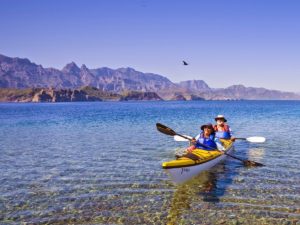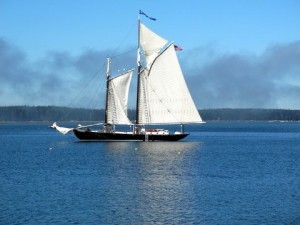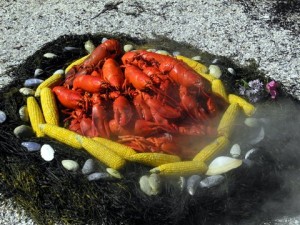baby boomers and tourism
Baby boomers are among the participnts in Miami Culinary Tours’ Little Havana tours, chowing down on Cuban food. Photo from Miami Culinary Tours
A decade or so ago, inspired by her mother’s love for cooking, Grace Della came up with the idea for a Cuban-inspired food tour of Miami, “back when nobody had ever heard of food tours there,” she says.
Since then, she and several other devoted foodies have developed their own company, Miami Culinary Tours, which now offers daily food tours (with cultural components) of Miami’s South Beach and Little Havana neighborhoods.
Led by knowledgeable guides — who love both food and local culture — the walking tours last about two to three hours and make anywhere from five to eight food stops at restaurants, cafes, delis, bakeries and other eateries. The stops may change a bit from tour to tour, but you can always count on… Continue reading
In previous posts on the Maine windjammers Nathaniel Bowditch (go here) and Isaac H. Evans (go here), I talked about the experiences of sailing aboard these historic vessels.

The Great Schooner Race of Maine windjammers, held each summer. Photo by Meg Maiden
Now I’d like to put the spotlight on the Maine Windjammer Association, which represents ten traditional Maine tall ships, seven of which are National Historic Landmarks. Collectively, it’s the country’s largest fleet of historic, passenger-carrying vessels.
Besides the Bowditch and the Evans, they include the American Eagle, the Angelique, the Heritage, the Lewis R. French, the Mary Day, the Stephen Taber, the Timberwind, and the Victory Chimes.
While all of the vessels are privately owned, the Association promotes and markets the windjammers as a group, producing significant savings in advertising budgets for each ship.
All… Continue reading
There’s something about being out on an historic Maine windjammer on quiet Penobscot Bay on a beautiful fall day to help you forget all the stuff that’s going on elsewhere in the country and the world.
That’s where my wife, Catharine, and I were the last weekend of September: aboard the two-masted, gaff-rigged topsail schooner Nathaniel Bowditch, in the company of nine other passengers and five crew members, including Captain Owen Dorr, who along with his wife, Cathie, has owned the ship for ten years.
First built as a private racing ship in 1922, the Bowditch later saw action as a coastal patrol boat in World War II, and subsequently served as a fishing vessel before finally being outfitted as a passenger ship.
It now holds up to 24 passengers, though with that many aboard the sleeping accommodations and eating… Continue reading
Quick: When you think of Maine, what image pops to mind first? Chances are it’s lobster.
Is there any other state so identified with one kind of food — or so dependent for its economy on one? Vermont and maple syrup, perhaps, or Florida and oranges — except that Florida has a much more diversified economy.
On a recent trip to Maine for a windjammer cruise aboard the historic Nathaniel Bowditch sailing ship — which I’ll be writing about in subsequent posts — I was struck by the thousands of lobster traps floating in Penobscot Bay off the town of Rockland, where our cruise took place.
Lobsters love the Maine coast as much as Maine loves lobsters, at least until they get caught. Maine has the ideal environment for lobsters to thrive —… Continue reading
Need a knee replacement? The medical tourist may combine surgery with a visit to the Taj Mahal.
Yes, we were once the hip generation — and we’re still pretty hip, if you ask me — but now many of us baby boomers are in the market for hip replacements. Not to mention knee replacements, heart bypasses, various forms of cosmetic surgery, and a host of other major medical procedures.
Alas, it goes with the territory of getting a little older, a little wizened, but…still wanting to remain as active and vibrant as possible for as long as possible.
And that’s where medical tourism comes in. In yesterday’s post I talked about the growth of medical tourism — traveling to other countries to have surgeries and other medical procedures done at a small fraction of what they would cost in the United States. And, as a byproduct of that less… Continue reading
With the U.S. health care system all too much in the news right now, it’s a good time to raise the issue of medical tourism: Americans — especially baby boomers — traveling to other countries to have surgeries and other medical procedures that cost a small fraction of what they do in the U.S.
And health permitting, many of these baby boomer medical tourists are taking the opportunity to see the sights of other countries as long as they’re traveling there anyway.
The most popular countries for medical tourism include Singapore, Thailand, India, Mexico, Costa Rica, Jordan, Turkey and Brazil.
That’s a pretty good bucket list of foreign destinations right there.
Need a knee transplant? See the unforgettable Taj Mahal in India and get a two-fer.
A heart bypass? You could leave your… Continue reading

Learn sea kayaking with Sea Kayaking Adventures
I was a little taken aback when I received a press release from a company called Sea Kayak Adventures titled “Baja, Mexico Gray Whales For the Gray-Haired,” promoting a whale-watching base camp trip in Baja intended for travelers aged 50-plus.
While I myself would more qualify for the “Baja Hairless Whales for the Hair-Impaired” trip — having turned gray (prematurely, of course) some years ago, and then deciding to go more for the mostly shaved-head look — I wondered whether 50-plus folks who retained dark hair (natural or otherwise) might feel offended or even forego the trip for that reason.
(Hey, stranger things have happened when it comes to deciding how to spend vacation dollars.)
So while I don’t recommend that promotional approach, exactly — is the play on “gray” really worth possibly costing business? — I have to say the trip… Continue reading
To supplement my previous post on the closing of U.S. national parks today, I’m reprinting an official advisory on the topic from the National Park Service. Read it and weep, if you love our national parks:
This park closed until further notice…
Government shutdown forces closures of 401 national parks
WASHINGTON – Because of the shutdown of the federal government caused by the lapse in appropriations, the National Park Service has closed all 401 national parks and suspended operation of dozens of community assistance programs.
All park grounds, visitor centers, hotels, campgrounds, and park roads – except for thru ways – are closed. All programs are canceled and permits issued for special events on park grounds nationwide are rescinded.
Park visitors in all overnight campgrounds and lodges have been given until no later than 6:00 p.m. Eastern Daylight Time on Thursday, October 3 to make other… Continue reading
A view of Acadia National Park — before the shutdown.
I was lucky enough to be in Acadia National Park along the stunning Maine coastline a few days ago, which is luckier than anyone who tried to enter the park today (October 1 as I write this).
Because of the federal government shutdown, Acadia — along with all other national parks and monuments — are closed today, and will be until Congress agrees to fund the government again.
The day I was there was a perfect fall day in Acadia: blue skies, blue sea, rugged rock formations, hiking trails snaking up hillsides and down to beaches, popovers baking at Jordan’s Pond House.
The rounded top of 1,500-foot-high Cadillac Mountain — offering panoramas looking out over Penobscot Bay, Bar Harbor and the heavily forested Maine countryside — was teeming with visitors enjoying the views, snapping pictures, and clambering over the rocks.… Continue reading
New York State Attorney General Eric Schneiderman: phony reviews will cost you.
In a previous post I discussed some of the good and bad aspects of TripAdvisor reviews, including possibly phony reviews that overexaggerate the positives or negatives of hotels, restaurants, and various travel activities, often to the point of ridiculousness.
Now New York State Attorney General Eric Schneiderman is cracking down on some businesses that have been giving themselves five-star reviews on sites like Yelp, Google, CitySearch and Yahoo.
Nineteen companies — including a charter bus company as well as non-travel-related businesses — have been ordered to stop writing or contracting for phony reviews of themselves and to pay a total of $350,000 in fines.
Schneiderman estimates that by next year one seventh of all the reviews on social media sites will be fakes.
So-called “reputation enhancement” companies are at the heart of the problem, hiring cheap foreign labor… Continue reading













